Genesis of the “light fast (T)boats”
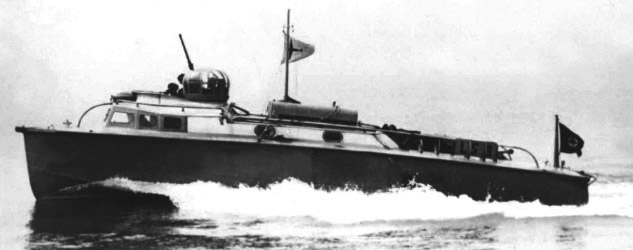
The German Leichte Schnellboote were a series of small and light S-Boote or fast torpedo boats, originally designed to operate from a cruiser or auxiliary cruiser. In the end, design difficulties meant that only two were deployed on two auxiliary cruisers (or commerce raiders), seeing mixed results. Instead, the rest of the production was focalized on coastal warfare, taking place mostly in the black sea.
Resurrection of the torpedo mothership concept
The need to design a very small and light torpedo boat was not required until WW2 broke out, as the already proven S-Boote was already equipping coastal defence flotillas of the Kriegsmarine, with more improved models to come: the mass-built S38, S100, and S701 groups.
However, in 1939, a series of commerce raiders were commissioned (HSK or “Handels Stör Kreuzer”) individually named “schiff-“, with plans to arm them with surplus WW-I cruiser naval guns, FLAK, mines, torpedo launchers, even reconnaissance planes. However, the large dimensions and available holds aboard made some wonder if they could deploy small attack boats as well.
One such idea was some sort of “special operation” use of the Hilfkreuzers as they could enter any harbour where a target of choice was at anchor, then at night launch two or more midget MTBs, causing havoc on short notice. This was not the resurrection of the old torpedo mothership concept, tested by Britain, France, and Italy, the first two with dedicated carrier cruisers in the late 1880s.
In the old guise, the concept, created in the wake of the first torpedo boat flotillas and the realization of possible applications for the Whitehead torpedo, was the idea to use a large mothership to bring the powerful but range-limited Motor Torpedo boats into close range of the enemy before launching them, somewhat like aircraft from a carrier. The idea was, if the concept was valid, to spread midget TBs on battleships as well as their already planned use on cruisers. After all, the latter already carried steam pinnaces and picket boats, which could have been equipped with old-style spar torpedoes if required.
The reality was quite different: These midget torpedo boats were too frail and too wimpy to face sea conditions even moderate seas. They became slow and very wet, and their small coal reserve was soon eaten by trying to reach their top speed while riding waves that often were taller than the boats themselves. Both the Royal Navy’s HMS Vulcan and the French Foudre were abandoned as a concept, as was the Italian Duilio which had its own “torpedo boat well” at the stern. The “torpedo mothership” concept would be resurrected decades later, in 1918, with the first torpedo-carrying aircraft of the pioneering aircraft carriers.
The need for a midget Torpedo Boat
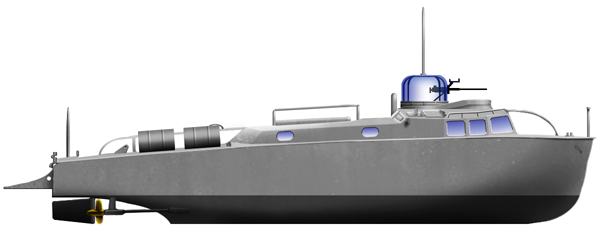
Author’s profile of the LS 2
Since the 100-ton, 40 m long S-Boote was totally unsuitable to be carried on any warship, it was obvious that a lighter model would have to be made for the Kriegsmarine’s inventory for these ‘Special Operations’ to work. On that note, the Regia Marina showed the way:
The MAS boats in service were already smaller than the German S-Boats, tailored for the Mediterranean, and new “spec ops” boats were tailored, to be carried by a mother ship/submarine, or even aircraft if needed: The 1939 MTM explosive motor-boat, the MAT or the MTR, but also midget torpedo boats, like the 1.7 tons MTS, MTSM, and MTSMA series, ranging from 1.7 to 3.65 tons and armed with two or a single 45 cm aviation type torpedo, launched aft like WWI MAS boats.
No doubt these nimble and very fast vessels carried quite a punch and could be carried and deployed by larger vessels. However unlike the Italian models, the LS boats were designed for long-range commerce raiding missions in all weather conditions and thus, their seaworthiness became the prime imperative, alongside other specifications, such as carrying mines and being able to deploy troops if needed. They were to be light, very fast, and versatile, to add real offensive value to a commerce raider or auxiliary cruiser (Hilfskreuzer).
Dorniers’s LS: Design Development (1936-1942)
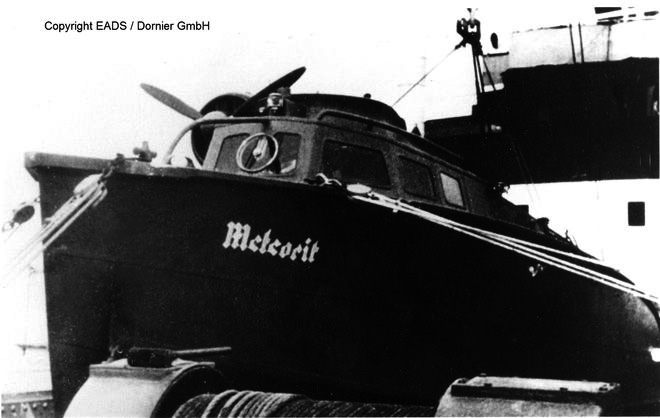
Dornier LS-2 “Meteorit” (Picture: EADS/Dornier GmbH )
In 1936 the Seekriegsleitung (SKl) or supreme command of the Kriegsmarine, requested a small S-boat suited to be carried by cruisers and auxiliary cruisers. The first design submitted by Lürssen was about 20 m long, with a layered monocoque structure of aluminum cladding backed by wood. The KSl declined production as it was still judged far too large to be operated on a mothership, and more notably, too large to be recovered. A draft was submitted in 1937 for a 12-13 m long boat, to be propelled by small but powerful diesel engines. Development of the latter however was left to be desired as none of the traditional specialists such as Maybach or MAN had any in R/D. However, Daimler Benz emerged as an unlikely leader in this category and began work on the engine.
Specifications also called for two either 53,3cm (21 in) standard marine torpedoes, or two airborne marine 45,7cm (18 in) models in tubes. It was also required that there should be one single 20mm FLAK gun, in an aviation-type glassed or plexiglass cupola. Studies with the trim after firing a torpedo led to a position during the design on the sides of the engine room rather than a classic stern-firing arrangement like WWI models, or a forward arrangement like in S-Boote.
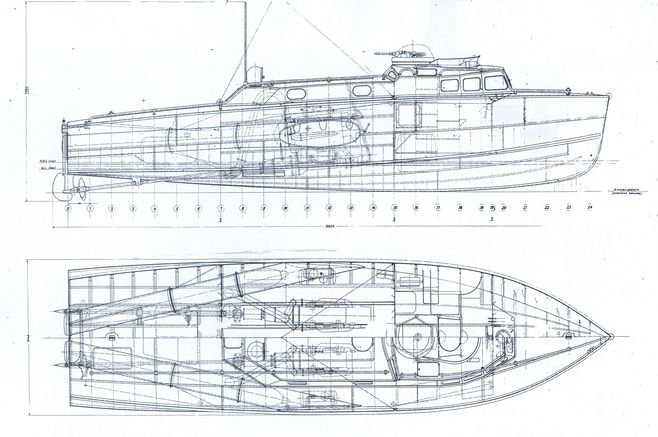
Detailed blueprint of the LS-II
Teams discussed the torpedo launch type, be it either stern-first or head-first. To deal with depth-steering stability, the torpedoes were to be launched stern-first. Otherwise, they ran the risk of being rammed by the boat. The steering arrangement and turning cupola design were redrawn, and the latter was posted aft of the bridge. Alternatives were studied, leading to different designs in 1938-39:
- V2 (1937) Composite-built wood/aluminium
- V2A (1938) All-aluminium prototype and mixed aluminium-steel (for the main framing), two boats ordered in 1938
- “LS 1” composite wood/aluminium built at Naglo, Berlin.
“LS 2” all-aluminium built by Dornier, Friedrichshafen-Manzell.
Both had on paper the same Junkers V12 piston four-stroke aircraft-diesel engines: The JuMo 205. These were a provisional solution until replacement by the Daimler Benz lightweight diesel engines which were still under development. Originally, both were to receive 18-in torpedo tubes, launched in a forward direction, however, this required a big hatch into the hull, and thus it was scrapped from construction. However, the torpedos, at 12,5 m long, 3,46 m wide, and 80 cm deep proved too large. Instead, an airborne torpedo, the F5, with a 45 cm diameter, 4,8 m length, and a 737 kg weight was used.
Dornier Flukzeugwerke was founded in Friedrichshafen in 1914 by Claude Dornier. The company rose to fame with its giant floatplane, the Dornier Do X, alongside its commercial success, the Wal. But after it began production for the Luftwaffe, its designs diversified, leading to such iconic models as the Do-17 “flying pencil” and its long lineage, or the revolutionary twin push-pull engineered Do-335 ‘Pfeil”: the fastest piston-engine fighter of WW2. By its historical roots, Originally Dornier Metallbau, working for Zeppelin, the company was probably the most gifted to deal with light construction in Germany.
At the outbreak of WW2, only two experimental midget S-boats were still in the works: “LS 1” and “LS 2”. In 1940, however, interest in their development was revived and the Dornier boat “LS 2” was fitted for war and embarked on Hilfskreuzer Komet (HSK 7). LS 2 was nicknamed “Meteor”. The planned for 45 cm torpedo tubes being not ready on time, minelaying rails were installed at the stern, the goal now being for the boats to lay mines to blockade habour entrances or rivers, using their shallow draft.
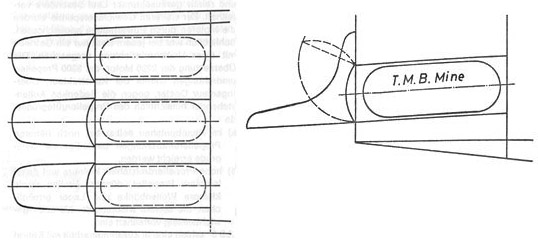
LS-II minelaying gear
Design-wise this was an important move. This minelaying gear was housed in three wells built in the stern, just large enough for an oblong TMB lightweight magnetic mine, launched from these “laying tubes”, all three side by side with round opening hatches. “LS 1” due to her construction was judged too heavy and barred from any use onboard an auxiliary cruiser. Instead, it became a test vessel for coastal operations.
At the time the Kriegsmarine had trouble obtaining delivery of the planned 20 mm FLAK 38 and instead, opted to fit the WWI vintage 6 cm gun as a stopgap solution. During acceptance trials, the Junkers engine caused a lot of issues. To start with, due to the light construction, vibration became so excessive that the top speed of the boats had to be drastically reduced. Also, being originally an aircraft engine and relocated inside a closed hull, cooling proved soon inadequate and the engine’s placement had to be redesigned entirely. By the end of June 1940, final acceptance trials, after revisions, were performed off Kiel over 200 nautical miles. The LS.II achieved a seven-hour run at a measured 28 knots, with peaks at 32 kts, which was a satisfying result for such a small craft.
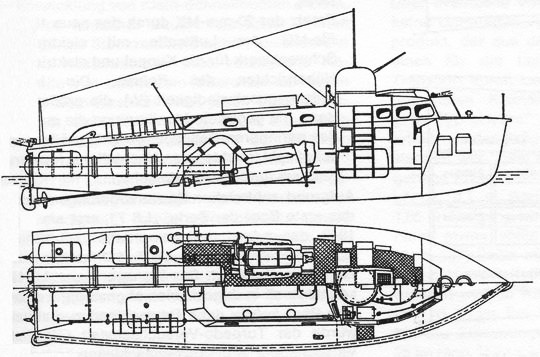
Cutaway of the LS V
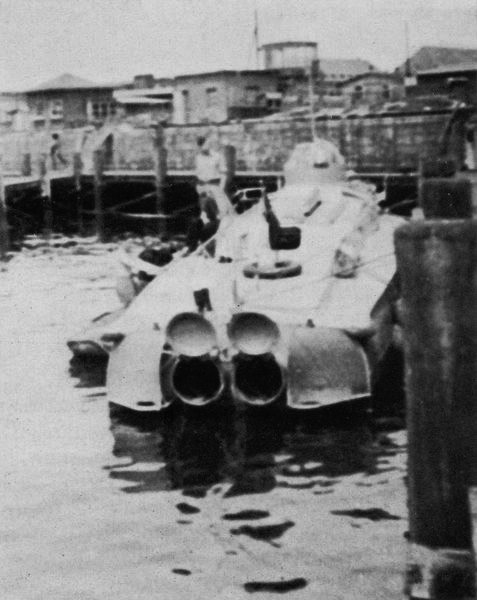
LS 4 showing her DC ports open aft
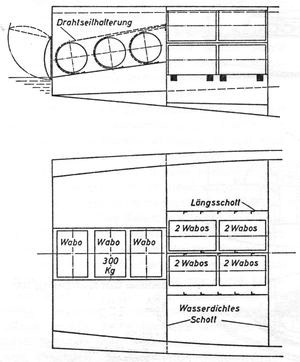
LS-5 Depht Charge rack system
⚙ Dornier-Werft Friedrichshafen, LS-2 serie design specs |
|
| Dimensions | 12.5 x 3.45 x 0.9 m ( feets) |
| Displacement | 11.5 tons standard |
| Crew | 7 |
| Propulsion | 2 Daimler-Benz MB 507 desel-engines 1100 PS |
| Speed | 38 knots ( km/h) |
| Range | Unknown |
| Armament | 2x stern TTs 45.7 mm (18 in), 2cm/1x 15 mm HMG HD 151 turret |
⚙ LS-4 serie |
|
| Dimensions | 13 x 3.46 x 0.9-1.02 m ( feets) |
| Displacement | 13 tons standard |
| Crew | 7 |
| Propulsion | 2x Diesel Junkers JuMo 205M or Daimler Benz MB 507 |
| Speed | 38-42.5 knots ( km/h) |
| Range | 300 nm at 30 kts |
| Armament | 2x stern TTs 45.7 mm (18 in)/3-4 mines, 15/20mm HMG FLAK +2 MG42 |
LS Boote in action
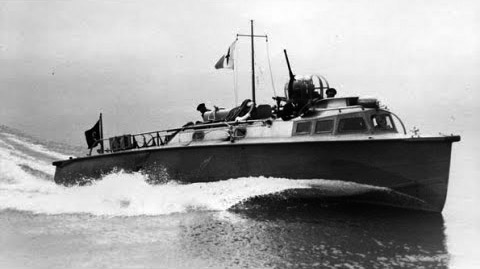
LS-3 in tests
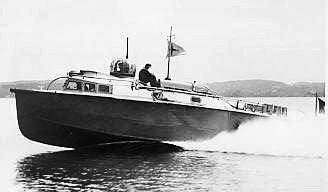
LS Boote speeding up
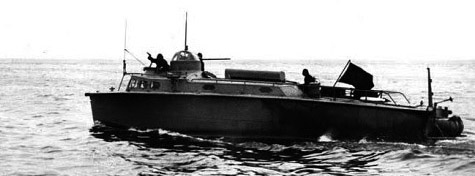
LS-3 on trials
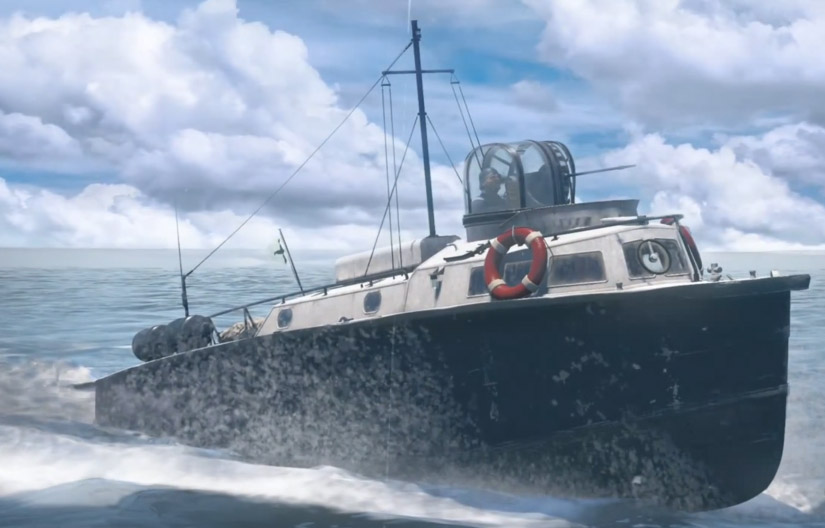
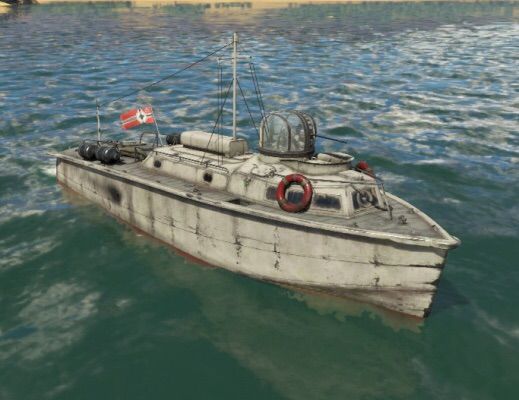
LS-renditions 3D wargaming
“Meteor” (LS-II) as it was named, performed lifting tests using marine types heavy weight booms, notably aboard an auxiliary cruiser, where the commercial booms already in place were able to lift heavy bulk payloads, and thus LS-II. Difficulties with the Junkers engines eventually caused a total loss of “Meteor” in early service. The overheating problem was never really cured and enflamed the wood and eventually aluminium around it. Not a single mine was ever laid by “LS 2” during her service on “Komet”.
The use of a light MTB was also considered to be used by the final product of the conversion of the MS Steirark to its most famous guise, the Kormoran in October 1940. It was planned to have her equipped with a single LS boat, which was at the time still on paper. LS boats would also be deployed to the Komet and Michel (LS1 to LS4). The series “LS 13” – “LS 34” ordered in 1942, was stopped in 1944, and the boats “LS 13” to “LS 18” were still in France during the liberation and lived to see French use. Other orders were cancelled by Speer in 1944.
Design-wise, the LS Boote was originally created by Dornier, a company well experienced with aluminium and light construction, but the provisional aviation engines caused many problems. So much so that the “Meteor” could not be deployed from “Komet”. In the spring of 1940 four more boats were ordered. “LS 3” and “LS 4” at last received the intended Daimler-Benz light MB 507 diesel engines. These boats were designed also as minelayers, but with a slightly different system with four instead of three mines.
LS 2 experience on HSK-7 Komet was not stellar: LS 2 was scheduled to make a sortie on December 23, to lay a minefield in front of Rabaul, then held by the Australians. But she just refused to start. The mechanical problem proved to be irreparable, and she was simply scuttled off the Bismarck archipelago.
“LS 3” was completed and tested on October 14th, 1940 and was to be deployed on the auxiliary cruiser “Kormoran” (HSK 8). LS 3 was able to lay 4 mines and like LS-II, was deployed on a few occasions in the south Pacific and the Indian Ocean, until its destruction during the Kormorans’ duel against the Australian cruiser HMAS Sydney on November 19, 1941.
“LS 4” however received the intended two aft 45,7 cm stern torpedo tubes produced Dornier in three months as well as newly developed propellers. She was able to achieve 42.5 knots. She was deployed aboard the auxiliary cruiser “Michel” (HSK 9), entering service in July 1941. She was very successful, sinking two vessels and assisting with the sinking of four others, for a total of 46.000 BRT. Statistically, she was the most successful of the whole series: On 22.04.1942 she sank the US turbine tanker “Connecticut” of 8.684 GRT, on 06.06.1942 the “George Clymer”, a 7.176 GRT Liberty ship along with the Norwegian “Aramis” 7.984 GRT. Later, on 30.11.1942, she sank the Greek freighter “Eugenie Livanos” (4.816 GRT), and on 17.06.1943 the Norwegian tanker “Ferncastle” (9.940 GRT), as well as the Norwegian tanker “India” on 11.09.1943. Her commanding officer was awarded the Deutsches Kreuz in Gold. She also evacuated sunken vessels’ crews, a lifesaving decision in the icy waters she hunted in, at a rate of up to 30 at a time. These attacks were mostly performed at night. She was sunk when Michel was torpedoed by USS Tarpon in October 1943.
“LS 5” and “LS 6” had Junkers aircraft engines and were intended to carry torpedos as well, but due to their engine issues, they were never deployed aboard commerce raiders. The OKM ordered both units fitted as submarine-chasers with six depth charges in two specially designed wells aft. They were designed to be operated by “MR 7”, Mittlere Räumboot 7. These were 21-27 tons Lürssen, Vegesack R-Boats designed for riverine and coastal operations. These were relocated to the Aegean Sea, in the Mediterranean. Their unit was later moved to the Black Sea where they were tested, but due to their crippling engine issues, never became operational.
LS 5 and 6 were deployed as escorts, the first on Lake Constance, the second in the Aegean Sea.
“LS 7” to “LS 12” received the intended MB 507 engines and they were built to carry two torpedoes. “LS 7” was delivered on 08.10.1943 and “LS 12” on 12.07.1944. All were deployed in the Aegean Sea. “LS 12”, was sent to Yugoslavia to be tested at a local torpedo facility; the Torpedo Trials Institute (Torpedoversuchsanstalt), and was subsequently captured by the Soviets in 1945. LS 6 was sunk by RAF fighter bombers. LS 5 was seriously damaged, and blown up to avoid capture. “LS 7” through “LS 11” were still transported to the Aegean Sea.
LS 4 (Esau) could have been armed either with an MG 151/20 or a 2 cm Flak 30/38. She served onboard the HSK 9 Michel and was very successful as seen above. LS 5 & LS 6 were fitted as coastal ASW vessels and had a sonar in complement of the MR 7 mines, however, they had issues with their two-stroke 6-cyl diesel Jumo 205 engines. Their 11 depth charges (six in tubes, four on deck) were completed by a single 2 cm Flak 38. MR 6 and MR 7 were refitted in 1942 with two 45 cm torpedo tubes but kept their deck mines according to photos. Up to LS 6, they were all completed in 1941, and LS 12 was the last completed in 1944. LS-7 to LS-11 were likely completed in 1943. Their design was slightly changed, with their masts removed, and a whip antenna fitted directly on the turret. 15 mm MG 151 were used in a twin mount inside the turret, but they kept their 57.2 cm torpedo tubes. They apparently had no sinking recorded and saw little service, notably due to the lack of diesel.
Crews are trained on the Lake Constance near Friedrichshafen, and from September 1943, LS 7-11 formed the 21st Schnellboot-Flotilla, specially created for them. In the spring of 1944, their flotilla was sent by rail to Athens, to operate between the Aegean Sea and the Adriatic. There, they intended to cripple Allied convoys passing by Otranto. From June 1944, they were based out of a Phaleron base in Rhodes, as well as in Leros, Corfu, and Patras. Records of the raids carried out seem to have little impact. The last raid from Corfu against the port of Bari was canceled in September 1944 due to bad weather. Called back to the Aegean Sea, they all ended up scuttled or destroyed by October of that year.
As said above, LS’s 13-34 were cancelled while in construction at Dornier in 1944. LS 13 – LS 18 were captured by France, while still incomplete. However, they were finished after capture. Finally, LS 19 – LS 34 were cancelled on the slipways. There was a project to use a submarine as a mothership, inspired by the Italian experience with Scirè: This was to be the U Boat Type IIIA in 1934. Two LSs were to be carried in an aft-enclosed hangar tube. Overall the Kriegsmarine was very critical of these boats, which motivated the cancellation of the project in 1944: Apart from LS-4’s successes, they suffered from deficient engines, poor construction, frequent water ingress, and seaworthiness issues due to their very light construction, vibrations, and very light armament.
They were often associated with the ‘LM boote’ or Küstenminenleger, coastal minelayer, which borrowed some concepts. These will be treated in a future standalone post.

Hypothetical reconstruction of the U-Boat Type IIIA carrying LS boats (never built).
About the KS Boote (1943)
As for the KLEINST SCHNELLBOOT (KS-BOOTE), they came from a program to convert Küstenminenleger delivered or completed, as Kleinst Schnellboote (“very small speedboats”) between March 1943 and November 1944. At least 21 units were thus transformed, including those engaged in the Gulf of Finland which had not yet been destroyed. They had two external 45cm torpedo tubes aft and a twin MG 151 in a rotating HD 151 Plexiglas turret aft of the bridge, plus a single MG 15 (7.92 mm) placed above the engine compartment on a pintle.
These KS-Boote were given the same role as the LS-Boote but on a greater displacement and therefore were more stable. Indeed, poor results of minelaying operations had them converted into MTBs in order to improve the capability of the too weak LSs. They were deployed in the Gulf of Finland, Aegean Sea, Adriatic, and Black Sea. They mostly attacked convoys at night and performed escort missions. In 1943-44, 14 new units were built to constitute mthe 22 Schnellboots-Flottille in December 1942. Training dragged on until May 1944, and the uint was transferred to Italy by train.
They should have been transferred to the Black Sea to reinforce the Danube flotilla, but ended at Lignano, between Trieste and Venice, and were mainly used for the instruction of Croatian sailors. By September-October, eight of them were officially redesignated KS 1-8, delivered permanently to the Croatian Navy, operating from Rijeka as the Kroatische Küsten-Schnellboots-Flottille, subordinated to the 11 Kriegsmarine’s Sicherungs-Division German Navy, a coastal auxiliary police force. The Ustashi regime however was confronted with incessant insurrections, and thus the small Ratna Mornarica Nezavisne Države Hrvatske was also plagued by sedition.
On the night of December 13 to 14, 1944, the entire KKS-Flottille planned to defect and sail to lake Nemi, held by Tito’s partisans. It failed because the port was guarded by the German Army and all sailors were arrested, bar the commander of the flotilla and a few men who managed to get through. German authorities then decided to send these crews to Zagreb as infantry, while the vessels were stripped of their armament. Souces about operations in the Aegean Sea or the Black Sea are very scarce and are even less satisfactory than those on the LS Boats. Camouflage-wise, they all stayed in regular grey color, but the boats of KM.22 stationed on Lake Ladoga circa 1943-44, were painted with a three-tone grey pattern.
Sources & more:
Books
None found so far.
Links
On german-navy.de
On de.wikipedia.org
On ocdroid.net
On navypedia
On fra.wiki
On wlb-stuttgart.de
On s-boot.net
On aminoapps.com
Future developments:
Naval Encyclopedia will also cover the following:
-TS 1-TS 6 hydrofoils, VS serie Half-Submarine-S-Boat, VS 6 minelayer hydrofoil, VS 7 TB hydrofoil, VS 8-9 Transport hydrofoils, VS 10 light S-Boat hydrofoil, the 1944 German built SMA light TBs, Hydra, the Kobra type very light S-Boats, the KS (coastal minelayers) and KS TB serie, the Schlitten I and Schlitten II small torpedo carriers, Wal I-II-III superfast TBs and other K-Verband projects.



 Latest Facebook Entry -
Latest Facebook Entry -  X(Tweeter) Naval Encyclopedia's deck archive
X(Tweeter) Naval Encyclopedia's deck archive Instagram (@navalencyc)
Instagram (@navalencyc)





 French Navy
French Navy Royal Navy
Royal Navy Russian Navy
Russian Navy Armada Espanola
Armada Espanola Austrian Navy
Austrian Navy K.u.K. Kriegsmarine
K.u.K. Kriegsmarine Dansk Marine
Dansk Marine Nautiko Hellenon
Nautiko Hellenon Koninklije Marine 1870
Koninklije Marine 1870 Marinha do Brasil
Marinha do Brasil Osmanlı Donanması
Osmanlı Donanması Marina Do Peru
Marina Do Peru Marinha do Portugal
Marinha do Portugal Regia Marina 1870
Regia Marina 1870 Nihhon Kaigun 1870
Nihhon Kaigun 1870 Preußische Marine 1870
Preußische Marine 1870 Russkiy Flot 1870
Russkiy Flot 1870 Svenska marinen
Svenska marinen Søværnet
Søværnet Union Navy
Union Navy Confederate Navy
Confederate Navy Armada de Argentina
Armada de Argentina Imperial Chinese Navy
Imperial Chinese Navy Marinha do Portugal
Marinha do Portugal Mexico
Mexico Kaiserliche Marine
Kaiserliche Marine 1898 US Navy
1898 US Navy Sovietskiy Flot
Sovietskiy Flot Royal Canadian Navy
Royal Canadian Navy Royal Australian Navy
Royal Australian Navy RNZN Fleet
RNZN Fleet Chinese Navy 1937
Chinese Navy 1937 Kriegsmarine
Kriegsmarine Chilean Navy
Chilean Navy Danish Navy
Danish Navy Finnish Navy
Finnish Navy Hellenic Navy
Hellenic Navy Polish Navy
Polish Navy Romanian Navy
Romanian Navy Turkish Navy
Turkish Navy Royal Yugoslav Navy
Royal Yugoslav Navy Royal Thai Navy
Royal Thai Navy Minor Navies
Minor Navies Albania
Albania Austria
Austria Belgium
Belgium Columbia
Columbia Costa Rica
Costa Rica Cuba
Cuba Czechoslovakia
Czechoslovakia Dominican Republic
Dominican Republic Haiti
Haiti Hungary
Hungary Honduras
Honduras Estonia
Estonia Iceland
Iceland Eire
Eire Equador
Equador Iran
Iran Iraq
Iraq Latvia
Latvia Liberia
Liberia Lithuania
Lithuania Mandchukuo
Mandchukuo Morocco
Morocco Nicaragua
Nicaragua Persia
Persia San Salvador
San Salvador Sarawak
Sarawak Uruguay
Uruguay Venezuela
Venezuela Zanzibar
Zanzibar Warsaw Pact Navies
Warsaw Pact Navies Bulgaria
Bulgaria Hungary
Hungary

 Bundesmarine
Bundesmarine Dutch Navy
Dutch Navy Hellenic Navy
Hellenic Navy Marina Militare
Marina Militare Yugoslav Navy
Yugoslav Navy Chinese Navy
Chinese Navy Indian Navy
Indian Navy Indonesian Navy
Indonesian Navy JMSDF
JMSDF North Korean Navy
North Korean Navy Pakistani Navy
Pakistani Navy Philippines Navy
Philippines Navy ROKN
ROKN Rep. of Singapore Navy
Rep. of Singapore Navy Taiwanese Navy
Taiwanese Navy IDF Navy
IDF Navy Saudi Navy
Saudi Navy Royal New Zealand Navy
Royal New Zealand Navy Egyptian Navy
Egyptian Navy South African Navy
South African Navy






























 Ukrainian Navy
Ukrainian Navy dbodesign
dbodesign